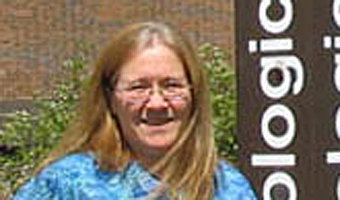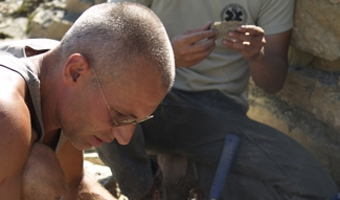
Cover of American Journal of Botany featuring microscopic photo of moss.
Research by Distinguished Professor Emeritus Gar Rothwell and two Ohio University alumni was featured on the cover of the April 2017 edition of American Journal of Botany.

Dr. Gar Rothwell
Their article—“Extending the fossil record of Polytrichaceae: Early Cretaceous Meantoinea alophosioides gen. et sp. nov., permineralized gametophytes with gemma cups from Vancouver Island”—discusses the oldest unequivocal record of the moss family Polytrichaceae. It is the first record of fossil moss gemma cups. And, the research establishes a minimum age for the family of 136 million years old.

Dr. Ruth Stockey
Co-author on the article include Dr. Alexander Bippus from Humboldt State University and two Ohio University alumni. Dr. Ruth Stockey ’74 earned an M.S. in Plant Biology from the College of Arts & Sciences at Ohio University. She is Professor of Botany and Plant Pathology at at Oregon State University.

Dr. Alexandru Mihial Tomescu
Dr. Alexandru Mihial Tomescu ‘o4 earned a Ph.D. in Plant Biology from the College of Arts & Sciences at OHIO. He is Professor of Biological Sciences at Humboldt State University.
Abstract
PREMISE OF THE STUDY: Diverse in modern ecosystems, mosses are dramatically underrepresented in the fossil record. Furthermore, most pre-Cenozoic mosses are known only from compression fossils, lacking detailed anatomical information. When preserved, anatomy vastly improves resolution in the systematic placement of fossils. Lower Cretaceous deposits at Apple Bay (Vancouver Island, British Columbia, Canada) contain a diverse anatomically preserved flora that includes numerous bryophytes, many of which have yet to be characterized. Among them is a polytrichaceous moss that is described here.
METHODS: Fossil moss gametophytes preserved in four carbonate concretions were studied in serial sections prepared using the cellulose acetate peel technique.
KEY RESULTS: We describe Meantoinea alophosioides gen. et sp. nov., a polytrichaceous moss with terminal gemma cups containing stalked, lenticular gemmae. Leaves with characteristic costal anatomy, differentiated into sheathing base and free lamina and bearing photosynthetic lamellae, along with a conducting strand in the stem, place Meantoinea in family Polytrichaceae. The bistratose leaf lamina with an adaxial layer of mamillose cells, short photosynthetic lamellae restricted to the costa, and presence of gemma cups indicate affinities with basal members of the Polytrichaceae, such as Lyellia, Bartramiopsis, and Alophosia.
CONCLUSIONS: Meantoinea alophosioides enriches the documented moss diversity of an already-diverse Early Cretaceous plant fossil assemblage. This is the third moss described from the Apple Bay plant fossil assemblage and represents the first occurrence of gemma cups in a fossil moss. It is also the oldest unequivocal record of Polytrichaceae, providing a hard minimum age for the group of 136 million years.



















Comments